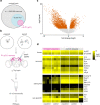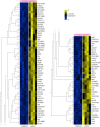This is a preprint.
Transcriptional profiling of Drosophila male-specific P1 (pC1) neurons
- PMID: 37986870
- PMCID: PMC10659367
- DOI: 10.1101/2023.11.07.566045
Transcriptional profiling of Drosophila male-specific P1 (pC1) neurons
Abstract
In Drosophila melanogaster, the P1 (pC1) cluster of male-specific neurons both integrates sensory cues and drives or modulates behavioral programs such as courtship, in addition to contributing to a social arousal state. The behavioral function of these neurons is linked to the genes they express, which underpin their capacity for synaptic signaling, neuromodulation, and physiology. Yet, P1 (pC1) neurons have not been fully characterized at the transcriptome level. Moreover, it is unknown how the molecular landscape of P1 (pC1) neurons acutely changes after flies engage in social behaviors, where baseline P1 (pC1) neural activity is expected to increase. To address these two gaps, we use single cell-type RNA sequencing to profile and compare the transcriptomes of P1 (pC1) neurons harvested from socially paired versus solitary male flies. Compared to control transcriptome datasets, we find that P1 (pC1) neurons are enriched in 2,665 genes, including those encoding receptors, neuropeptides, and cell-adhesion molecules (dprs/DIPs). Furthermore, courtship is characterized by changes in ~300 genes, including those previously implicated in regulating behavior (e.g. DopEcR, Octβ3R, Fife, kairos, rad). Finally, we identify a suite of genes that link conspecific courtship with the innate immune system. Together, these data serve as a molecular map for future studies of an important set of higher-order and sexually-dimorphic neurons.
Keywords: Courtship Behavior; Drosophila melanogaster; Transcriptomics.
Figures







Similar articles
-
The neural basis for a persistent internal state in Drosophila females.Elife. 2020 Nov 23;9:e59502. doi: 10.7554/eLife.59502. Elife. 2020. PMID: 33225998 Free PMC article.
-
Sexual arousal gates visual processing during Drosophila courtship.Nature. 2021 Jul;595(7868):549-553. doi: 10.1038/s41586-021-03714-w. Epub 2021 Jul 7. Nature. 2021. PMID: 34234348 Free PMC article.
-
Central neural circuitry mediating courtship song perception in male Drosophila.Elife. 2015 Sep 21;4:e08477. doi: 10.7554/eLife.08477. Elife. 2015. PMID: 26390382 Free PMC article.
-
Neurogenetics of courtship and mating in Drosophila.Adv Genet. 2008;62:67-184. doi: 10.1016/S0065-2660(08)00603-2. Adv Genet. 2008. PMID: 19010254 Review.
-
Neuroethology of male courtship in Drosophila: from the gene to behavior.J Comp Physiol A Neuroethol Sens Neural Behav Physiol. 2014 Apr;200(4):251-64. doi: 10.1007/s00359-014-0891-5. Epub 2014 Feb 25. J Comp Physiol A Neuroethol Sens Neural Behav Physiol. 2014. PMID: 24567257 Review.
References
-
- Spieth H T. Courtship behavior in drosophila. Annu. Rev. Entomol., 19:385–405, 1974. - PubMed
-
- Greenspan R J and Ferveur J F. Courtship in drosophila. Annu. Rev. Genet., 34:205–232, 2000. - PubMed
-
- Kimura Ken-Ichi, Hachiya Tomoaki, Koganezawa Masayuki, Tazawa Tatsunori, and Yamamoto Daisuke. Fruitless and doublesex coordinate to generate male-specific neurons that can initiate courtship. Neuron, 59(5):759–769, September 2008. - PubMed
-
- Demir Ebru and Dickson Barry J. fruitless splicing specifies male courtship behavior in drosophila. Cell, 121(5):785–794, June 2005. - PubMed
Publication types
Grants and funding
LinkOut - more resources
Full Text Sources
Research Materials
Miscellaneous
